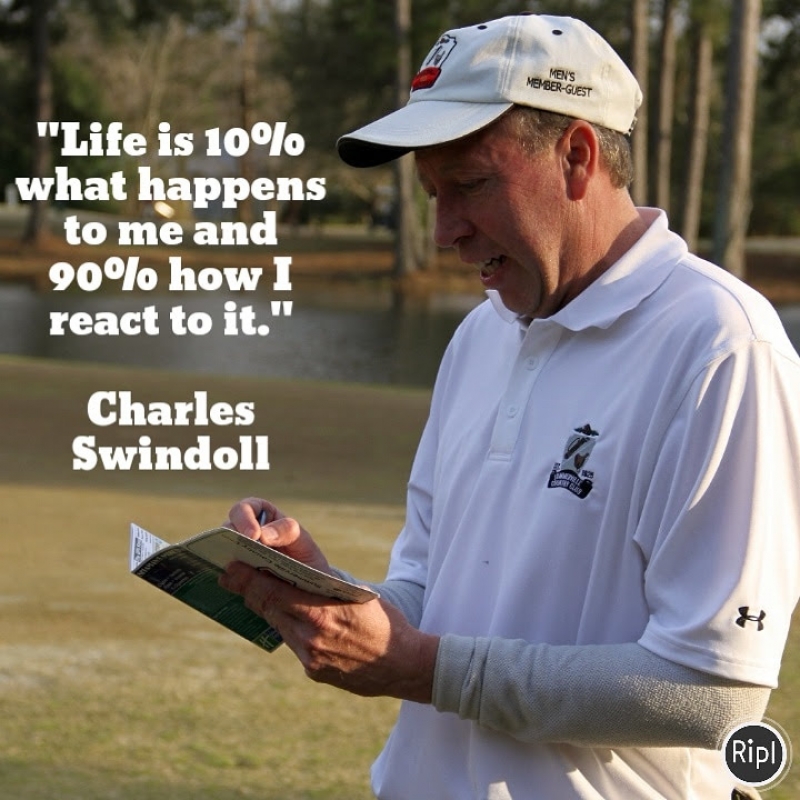An Athlete's Courage: A Story of Traumatic Brain Injury (TBI) Recovery

Rich O’Brien is an adaptive golf instructor who works with advanced and disabled golfers, using golf as therapy. Rich has over 30 years of experience, but he also has his own harrowing narrative about traumatic brain injury and how golf, amongst other factors, helped him in his healing process. We are honoured to have Rich share his story with our readers.
On September 25th, 2008, Rich was finishing a round of golf on Kiawah Island when his golf cart made a sharp left turn that caused him to be ejected from the vehicle. This accident resulted in direct trauma to his head and neck, causing a litany of injuries: a broken neck (C1/C2), broken back (L4/L5), 4 skull fractures, brain damage in every lobe of his brain due to subdural, subarachnoid and epidural hematomas, and a lack of oxygen for at least four and a half minutes. Luckily, there was an EMT that worked at the golf course who came to Rich’s aid, but in the time it took for the EMT to arrive on scene, the pooling of blood in Rich’s brain caused him to exhibit epileptic seizures.
When Rich was finally brought to the hospital, he was in an induced coma in order to prevent the seizures from further compounding his injuries, as seizures are especially dangerous when head and neck injuries are involved. He was in this state for several days and when he awoke, he thought he was paralyzed and had trouble talking and understanding his doctors and care team. “I was knocked into next week,” he said. “I had no memory of the accident, but my indelible mark was that I woke up thinking that I was paralyzed from the neck down.”
Following the accident, Rich was haunted by the possibility of paralysis and used it as motivation during his recovery. He used extreme exercise (over 12,000 hours of rehabilitation) and golf therapy to increase his endorphins, which helped him manage his chronic pain, PTSD and his dependency on opioid medications. In addition, he credits scalp acupuncture as a major driver to getting back to where he is today, a method that takes advantage of neuroplasticity to reroute around the brain damage.

Rich’s acupuncturist was an instructor who had trained many future acupuncturists in Los Angeles before relocating to South Carolina. Scalp acupuncture itself is a relatively new field of acupuncture therapy developed in the 1970s. As explained to him by his acupuncturist, the acupuncture was akin to rebooting the central nervous system, and specific nerves were targeted with the treatments. This treatment focused on seven conditions that his physicians struggled with help him with: chronic pain, chronic inflammation, chronic fatigue, chronic sleep disorder, a delta wave issue with seizures, PTSD, and a serious addiction to prescription painkillers.
His PTSD was also addressed with “six-needle” acupuncture, which regularly drained off his negative energy. The treatments would result in an immediate positive effect that would remain for three to four days until the negative energy would accumulate; therefore, in order to stay on top of his symptoms, he would undergo semiweekly treatments. He and his care team also noticed that the frequency of treatments led to amazing advancements for his complex series of injuries that his doctors could only attempt to manage with medication. Furthermore, Rich was also noticing that he was able to get some restorative REM sleep again, which had been lacking for 3.5 years.
Within two months of acupuncture treatment, his chronic pain, chronic inflammation, chronic fatigue, chronic sleep disorder and delta wave issues were completely gone. His PTSD symptoms were ameliorated with occasional maintenance treatments every other week in combination with strenuous exercise and golf therapy. Wonderously, Rich described the combination of PTSD treatment and scalp acupuncture treatment having the effect of, “snapping breaker switches shut that had been wide open for 3.5 years.” His addiction to pain medications took several more months to eliminate, however, finally having overcome the dependency in July 2012.
Upon his recovery, Rich met and befriended Fred Gutierrez, a veteran who had suffered from a gunshot wound to the head. Consequently, Fred had a golf-ball sized hole in his temporal lobe and generalized weakness and spasticity all over the left side of his body. Fred had been managing his symptoms with a combination of prescription medications and Botox. With Rich’s assistance, Fred learned to golf and despite his partial paralysis, walked the golf course for exercise. Rich then introduced Fred to acupuncture. During his first session, Fred was able to voluntarily move his left hand and left foot for the first time in 17 years – a feat so poignant and sweet that it brought him to tears. Fred’s case truly epitomizes what is possible with scalp acupuncture.

For Rich, he himself had made such amazing progress in his recovery, so much that he walked nine holes at Summerville Country Club just a year following the accident. His tenacious spirit and positive attitude is an inspiration to golfers everywhere. At the moment, no one would have ever guessed that Rich had experienced a traumatic brain injury. Despite his extensive list of injuries, he is the Editor of Long Drive Golf Magazine, the father of Golf Therapy, and, once again, a scratch golfer. Rich documented the story of his accident and subsequent recovery process in his book, “Half-Paralyzed, Twice Strong,” written with his partially paralyzed friend. Together, they have been the impetus for founding numerous adaptive golf therapy programs around the world.
For more information on scalp acupuncture and the leading authority on the subject, Professor Zhu Mingqing, please visit https://scalpacupuncture.org/






